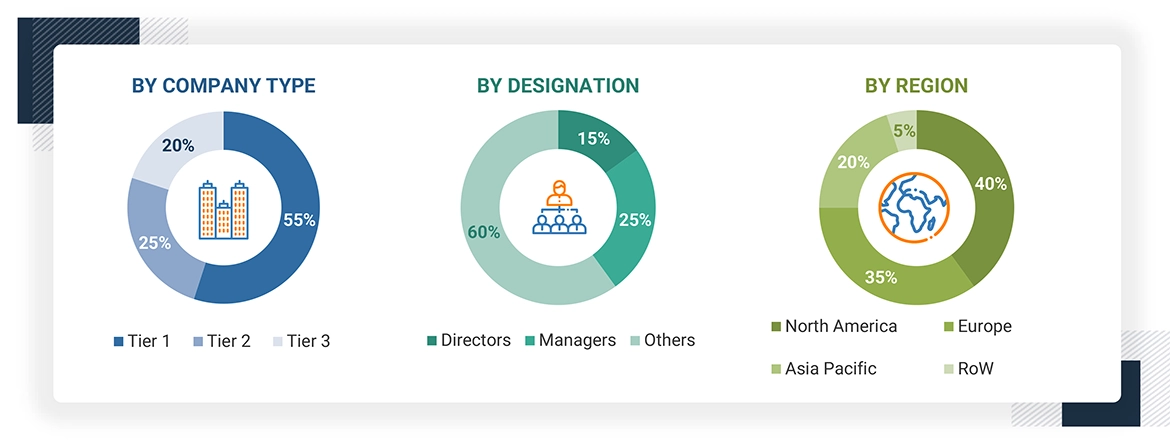This research study involved the extensive use of secondary sources—directories and databases such as Bloomberg Businessweek and Factiva—to identify and collect information useful for a technical, market-oriented, and commercial study of the food certification market. In-depth interviews were conducted with various primary respondents—such as key industry participants, subject matter experts (SMEs), C-level executives of key market players, and industry consultants—to obtain and verify critical qualitative and quantitative information as well as to assess prospects.
Secondary Research
In the secondary research process, various sources, such as the International Organization for Standardization, The Global Food Safety Initiative (GFSI), Food and Drug Administration (FDA), United States Department of Agriculture (USDA), The Institute of Food Technologists (IFT), Centers for Disease Control and Prevention (CDC), European Food Safety Authority (EFSA), European Federation of National Associations of Measurement, Testing and Analytical Laboratories (EUROLAB), Food Safety and Standards Authority of India (FSSAI), and Food Standards Australia New Zealand (FSANZ) were referred to identify and collect information for this study. The secondary sources also include clinical studies and medical journals, press releases, investor presentations of companies, white papers, certified publications, articles by recognized authors and regulatory bodies, trade directories, and paid databases.
Secondary research was mainly conducted to obtain critical information about the industry’s supply chain, the total pool of key players, and market classification & segmentation according to the industry trends to the bottom-most level and geographical markets. It was also used to obtain information about the key developments from a market-oriented perspective.
Primary Research
The market comprises several stakeholders in the supply chain, which include raw material suppliers, equipment suppliers, and food certification systems, kits, and consumables manufacturers. Various primary sources from both the supply and demand sides of the market were interviewed to obtain qualitative and quantitative information. The primary interviewees from the supply-side include food certification manufacturers. The primary sources from the demand-side include distributors, importers, exporters, and end consumers.

*RoW includes the South America Middle East and Africa.
To know about the assumptions considered for the study, download the pdf brochure
Market Size Estimation
Both the top-down and bottom-up approaches have been used to estimate and validate the total size of the food certification market. These approaches were extensively to determine the size of the subsegments in the market. The research methodology used to estimate the market size includes the following details:
Food Certification Market : Top-Down and Bottom-Up Approach
Data Triangulation
After arriving at the overall market size from the estimation process explained above, the total market was split into several segments and subsegments. The data triangulation and market breakdown procedures were employed, wherever applicable, to estimate the overall food certification market and arrive at the exact statistics for all segments and subsegments. The data was triangulated by studying various factors and trends from the demand and supply sides. Along with this, the market size was validated using both the top-down and bottom-up approaches.
Market Definition
The food certification market involves the certification of food products, production processes, and supply chains to ensure compliance with standards related to safety, quality, sustainability, and regulatory requirements. Certification bodies like ISO, BRC, and SQF provide independent assessments, covering food safety, product quality, sustainability practices, religious compliance (Halal, Kosher), and "free-from" standards (e.g., gluten-free). Key end-users include food and beverage manufacturers, retailers, restaurants, growers, and logistics providers. This market is driven by rising consumer demand for safe, sustainable food, stringent regulatory frameworks, and the need for compliance in global food trade. Certifications help businesses ensure product credibility, enhance consumer trust, and facilitate market differentiation.
Stakeholders
-
Food certification service providers
-
Food technologists
-
Food product manufacturers
-
Raw material suppliers
Report Objectives
MARKET INTELLIGENCE
-
To determine and project the size of the food certification market with respect to the certification type, application, end-user, certification scope, price sensitivity and region, over five years, ranging from 2024 to 2029.
-
To identify the attractive opportunities in the market by determining the largest and fastest-growing segments across the key regions
-
To analyze the demand-side factors based on the following:
-
Impact of macro-and micro-economic factors on the market
-
Shifts in demand patterns across different subsegments and regions.
COMPETITIVE INTELLIGENCE
-
To identify and profile the key market players in the food certification market.
-
To determine the market share of key players operating in the food certification market
-
To provide a comparative analysis of the market leaders based on the following:
-
Service offerings
-
Business strategies
-
Strengths and weaknesses
-
Key financials
-
To understand the competitive landscape and identify the major growth strategies adopted by players across the key regions.
Available Customizations
With the given market data, MarketsandMarkets offers customizations according to company-specific scientific needs.
The following customization options are available for the report:
Product Analysis
-
Product Matrix, which gives a detailed comparison of the product portfolio of each company
Geographic Analysis as per Feasibility
-
Further breakdown of the Rest of Europe market for food certification into the Czech Republic, The Netherlands, Belgium, Hungary, Romania, and Ireland
-
Further breakdown of the Rest of South America market for food certification into Chile, Colombia, Paraguay, and Peru
-
Further breakdown of other countries in the RoW market for food certification into the Middle East & Africa
Company Information
-
Detailed analyses and profiling of additional market players (up to five)



Growth opportunities and latent adjacency in Food Certification Market